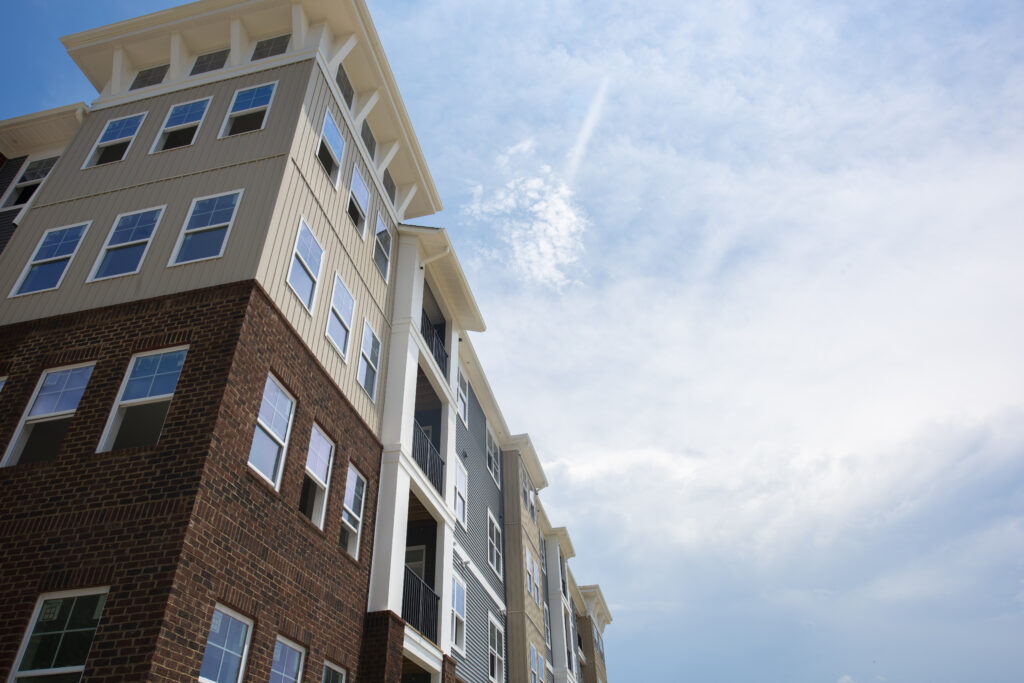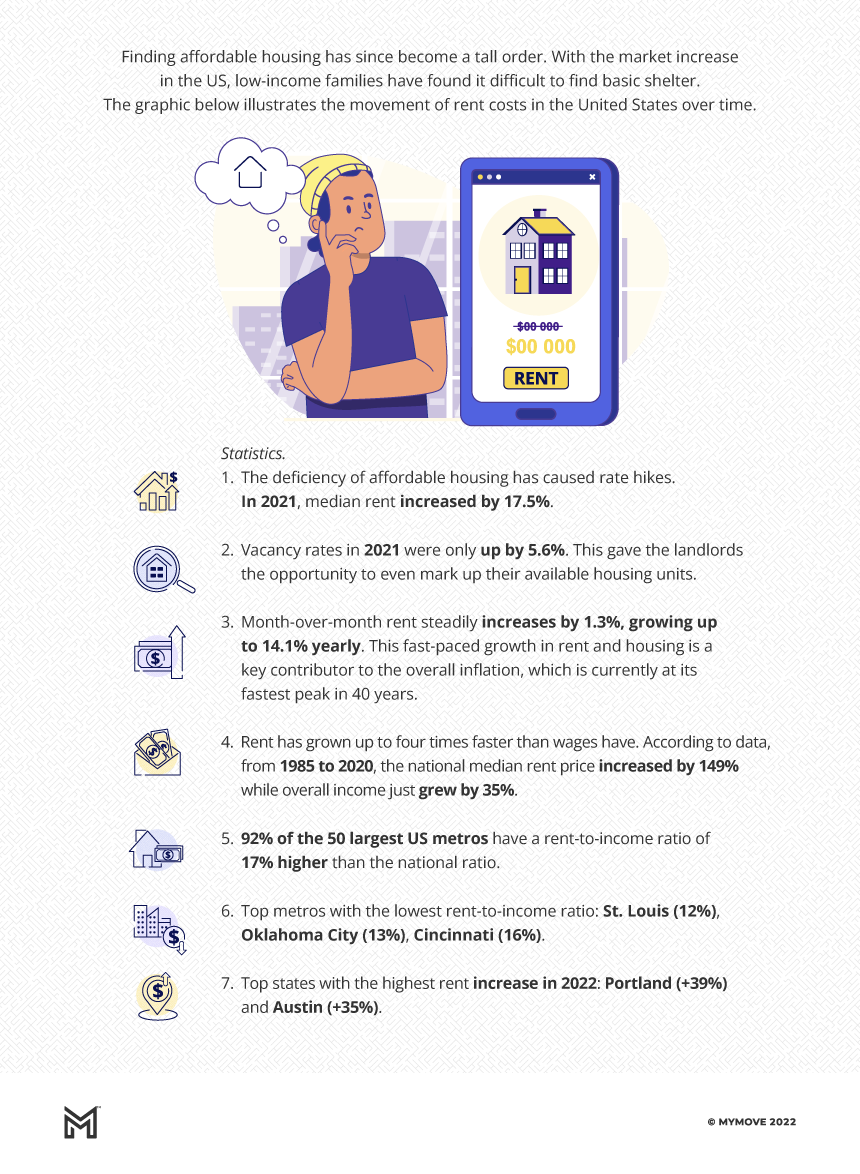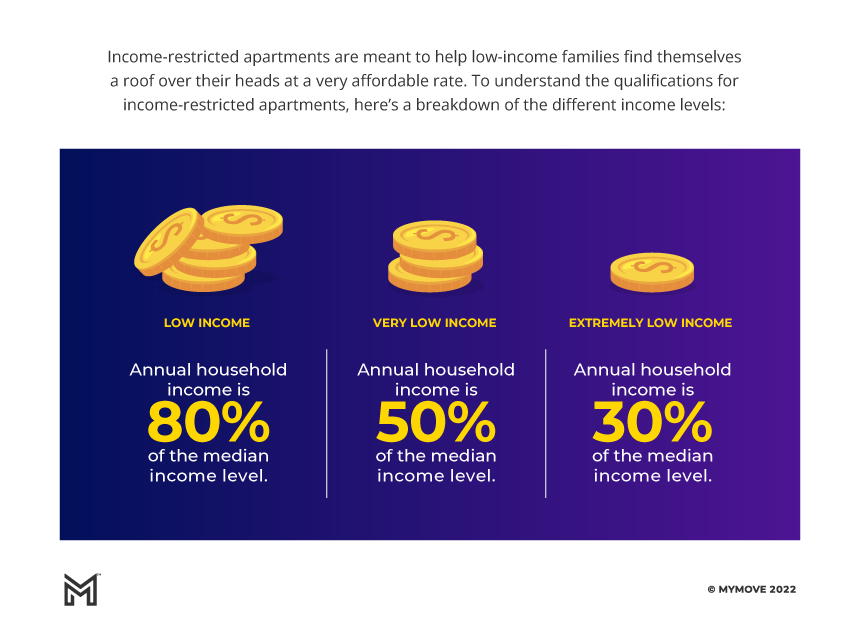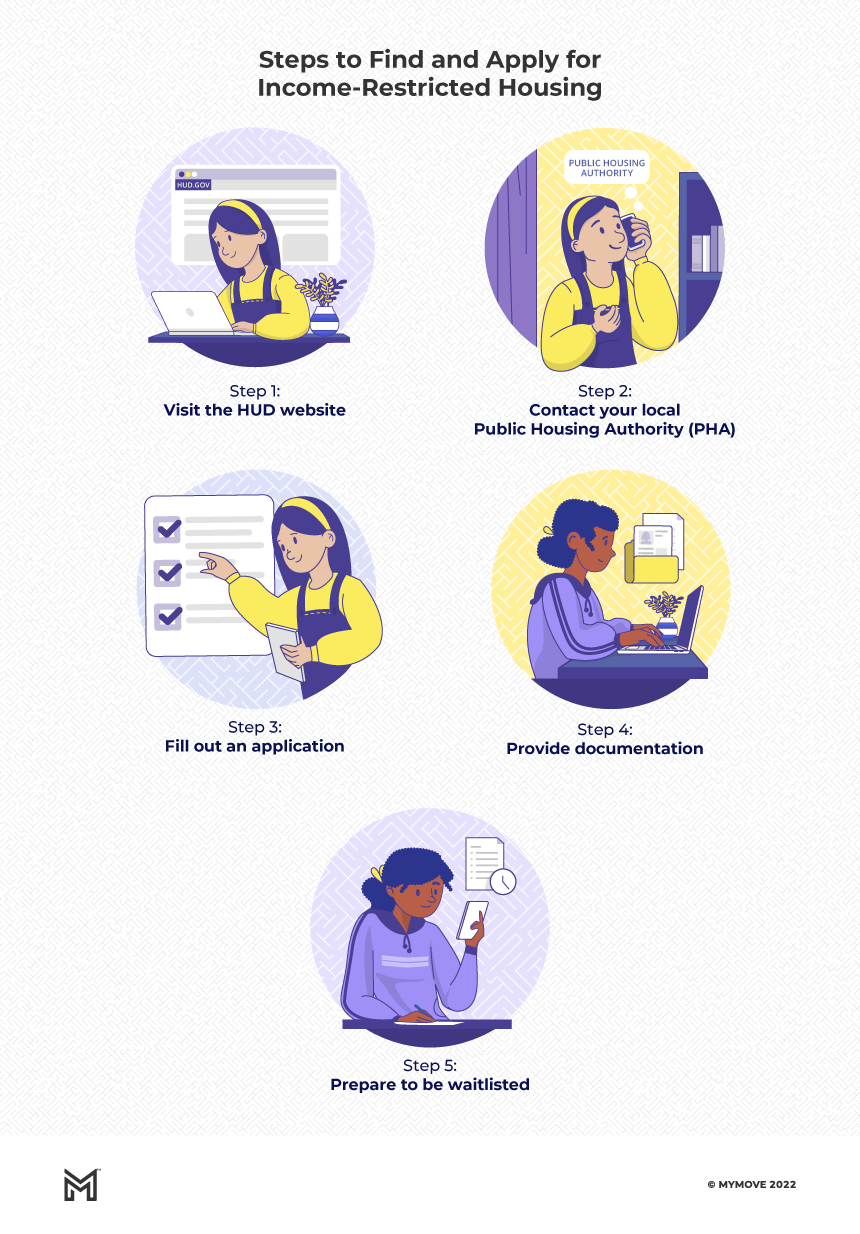What Are Income-Restricted Apartments?

If your income is low, you may qualify for an income-restricted apartment in your community. These affordable housing units, also known as rent-restricted apartments, are designed for low-income families, singles, and couples looking for a place to live. But what does “income-restricted” mean, and how do you apply?
Income-restricted apartments are regulated by a complex web of federal, state, and local guidelines, so it’s essential to check on your particular area’s rules. Here, we provide a general guide to understanding, finding, and applying for income-restricted housing.
Jump to:
What are income-restricted apartments?
Are income-restricted apartments the same as income-based housing?
Who qualifies for income-restricted housing?
How to find and apply for income-restricted housing, step by step
Moving into an income-restricted apartment
What are income-restricted apartments?
As the name suggests, income-restricted apartments are available only to those whose income falls into a specific range. They may be owned by the city or by private owners who receive government subsidies. Many income-restricted apartments are in designated apartment communities, though some complexes have a mix of both income-restricted units and market-rent units.
The history behind income-restricted housing
Affordable housing became a federal concern in response to the housing crisis caused by the Great Depression. The agency that would become HUD (Housing and Urban Development) and the predecessor to the U.S. Department of Agriculture’s Rural Development department were established in the early 1930s.
In the 1950s and 1960s, the federal government passed several measures to create new affordable rental housing and subsidize the costs of operating income-restricted apartments. The 1960s also brought landmark Civil Rights legislation to prevent housing discrimination, and put a cap on the percentage of income public housing residents are expected to pay (then 25%, today 30%).
Starting in the 1970s, the federal government began transferring much of the responsibility for affordable housing to state and local governments. Today there’s a patchwork of agencies, nonprofits, and associations in each state working to provide safe, income-restricted housing to meet citizens’ needs.

Are income-restricted apartments the same as income-based housing?
Income-restricted apartments and income-based housing are slightly different. Rent for an income-restricted apartment is capped at a percentage of the median income for the area, and it’s based on the apartment’s size.
Income-based housing, on the other hand, is capped at 30% of the tenant’s gross income. In both cases, the remainder of market value rent is subsidized by the government.
Types of housing subsidies
There are several different types of housing subsidies available, and they depend on the state and city that you live in. These are both provided by the federal government, but there may be local subsidies available to you as well.
Section 8 Housing
The Section 8 Housing Choice Voucher program is the most commonly used form of rent assistance, with more than 5 million people in the U.S. using it to help pay the rent.
- Available to very low-income families, the elderly, and the disabled.
- Income must be under 50% of median income for the county or metropolitan area (and typically under 30%).
- Housing isn’t limited to subsidized housing projects.
- On average, households pay between 30% and 40% of income on rent.
- At least one person in the household must have legal documentation to be living in the U.S.
- The tenant is responsible for the security deposit.
- After you get your voucher, you’ll have at least 60 days to find housing, but you can ask the housing authority for an extension.
- Contact your local Public Housing Agency for more information.
Low-Income Housing Tax Credit
The Low-Income Housing Tax Credit (LIHTC) is a federal program that gives $8 billion per year in tax credits to state and local agencies to issue for the acquisition, rehabilitation, or new construction of rental housing targeted to lower-income households.
- Awarded to private developers through a competitive bidding process.
- A percentage of the building’s units must be occupied by low-income tenants.
- Developers who receive the credit must provide a percentage of housing at reduced rates to low-income tenants.
- The LIHTC has subsidized over 3 million housing units since it was created in 1986, making it the the largest source of affordable housing financing.
Public housing
Unlike Section 8 Vouchers, affordable public housing developments are owned and operated by local Public Housing Authorities.
- Eligible if you earn at or below 80% of median area income.
- 40% of units are reserved for families that earn at or below 30% of median area income or federal poverty guidelines, whichever is greater.
- Families pay 30% of their adjusted income toward rent.
- Currently one million public housing units under contract with the federal government.
Who qualifies for income-restricted housing?
Because median income levels vary by states and local areas, income requirements for income-restricted housing differ as well. Every year, HUD calculates the median income for each metro area in the country. It then determines the maximum income, based on family size, that qualifies as “Low,” “Very Low,” or “Extremely Low” for that metro area.

In many cities, income-restricted housing is limited to those whose income is “Very Low” for that area, with preference given to those with “Extremely Low” income. However, if your income is considered “Low,” it’s worth seeing if any local programs are available to you.
Other factors that are considered include how many people will be living in the household, U.S. citizenship status, and eviction history.
How much do you pay in rent for income-restricted apartments?
Like median income, average rent prices for income-restricted apartments also vary across the country. Different localities calculate the maximum rent that landlords can charge for income-restricted units in different ways. To learn what you would need to pay based on apartment size, contact your local housing authority.
How to find and apply for income-restricted housing, step by step

Step 1: Visit the HUD website
Here you can learn the income guidelines for your metro area.
Step 2: Contact your local public housing authority (PHA)
This will help you determine how much rent would be based on your desired apartment size, and get a list of available rentals near you.
Step 3: Fill out an application
You can apply through the PHA if you’re seeking a government-owned apartment or directly through the landlord for privately owned properties. Note that you and everyone who will live in the apartment may need to pass a criminal background check. Which offenses are disqualifying depends on the location, and some private owners may have stricter standards.
Step 4: Provide documentation
You’ll need to prove your income and the combined household income of everyone who will live in the apartment. All adults will need a photo ID, and you will need to provide birth certificates or other proof of age for any children.
Step 5: Don’t worry if you get waitlisted
In some cities, affordable housing is at a premium, with more qualified applicants than available places to live. You may need to wait in line, especially if you want public rather than privately owned housing. Being flexible about apartment size and whether it is income-restricted or income-based may help shorten your wait.
Moving into an income-restricted apartment
Like all moves, moving into an income-restricted apartment requires its fair share of preparation. Here are the steps you’ll need to take to make it go as smoothly as possible.
Find your local Public Housing Agency
The process for securing an income-restricted apartment looks a little different in every city. Before you start your housing search, find the local Public Housing Agency in the area you want to live to learn what options are available to you. You can contact them through their email or phone number, or Google their name. Most local housing authorities have websites that help you see what kind of assistance you qualify for.
See what your income qualifies you for
Different housing programs have different income requirements, and it can feel incredibly complicated to just find out what you’re actually eligible for. The best way to make sure you know all your options is to contact your local Public Housing Agency, but you can also use HUD’s Income Limits tool to get a better idea of where you stand.
Attend a housing briefing
All housing authorities require that you attend an in-person briefing before you get your voucher. Use this opportunity to ask any remaining questions you may have about the process. Typically, you’ll get a notice in the mail about when and where the briefing will take place.
Find an apartment
Depending on the income-restricted housing program you’re applying for, you may have a lot of options when it comes to your apartment search. The best way to do this is by using one of many apartment-finding websites out there like Zillow, Craigslist, or Apartments.com. That said, rental scams can be an issue, so it’s important to follow best practices like never sending money before seeing the apartment in-person.
The bottom line
Income-restricted and income-based housing can be a lifeline for those with low income. You’ll need to jump through some hoops, and possibly get on a waiting list, but especially in high-rent cities, it can make housing relatively affordable.
Frequently asked questions
-
For traditional, market-value apartments, many landlords require an income of at least three times the monthly rent, which can be difficult for low-income renters to manage. Income-based and income-restricted apartments may be the best solution — as the rent price is typically only a fraction of local market rent, with the rest made up in government subsidies.
-
Probably. Private landlords can run a credit check and set a minimum qualifying score, but this is generally much easier to meet in low-income apartments than traditional market-rate housing. Additionally, you may not be disqualified based on a lack of credit history.
-
Income-based apartments set your rent at 30% of your adjusted gross household income.
-
For traditional, market-value apartments, many landlords require an income of at least three times the monthly rent, which can be difficult for low-income renters to manage. Income-based and income-restricted apartments may be the best solution — as the rent price is typically only a fraction of local market rent, with the rest made up in government subsidies.



